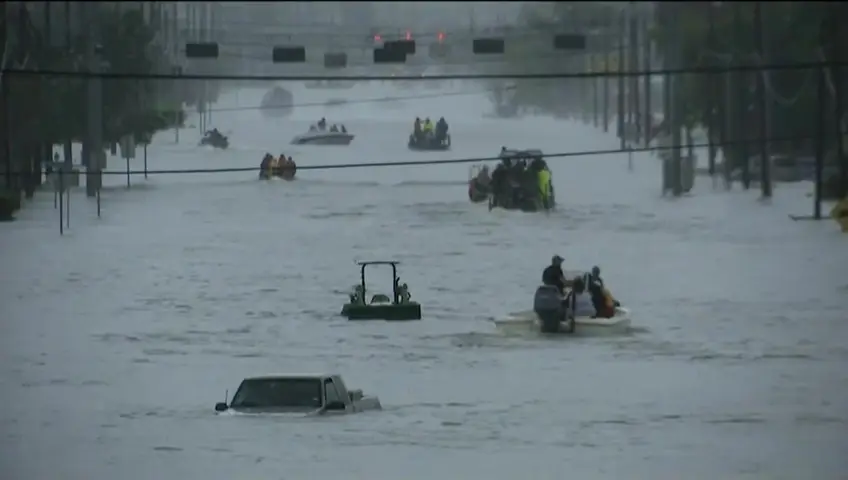
Unmasking the Flood: Texas, Tragedy, and the Politics No One Wants to Name.
Posted in :
Texans didn’t die just because it rained. They died because public safety infrastructure was gutted. Seth Abramson says Trump and Musk ignored expert warnings, slashed disaster programs, and left communities vulnerable. When infrastructure fails by political design, the deaths are political. Pretending otherwise only ensures more tragedy.
When devastating floods struck Texas, more than 50 lives were lost—not just to rising waters, but to political decisions that left public services crippled. Author Seth Abramson openly blamed Donald Trump and Elon Musk for gutting disaster programs, arguing that their brand of cost-cutting caused avoidable deaths. This post explores the human cost behind those policy choices, the failures of warning and infrastructure, and the uncomfortable but vital call for Democrats to confront the truth head-on.
Everyone remembers that electric feeling when a thunderstorm sweeps through Texas Hill Country—until the skies hardly seem to stop. The recent floods didn’t just fill rivers; they exposed the cracks beneath our feet. As someone who’s sat through city council meetings debating drainage budgets and once watched my neighbor frantically sandbag his porch, it’s easy to see how these catastrophes become personal. But is it only about the weather? Or, as Seth Abramson suggests, do political decisions set the stage for tragedy long before the rain falls?
When Politicians Play Disaster Expert: Blame, Context, and a Broken System
When the Texas flood death toll climbed past 50, the public conversation followed a predictable script: shock, sympathy, and vague calls for “resilience.” But then Seth Abramson, Trump biographer and outspoken critic, broke through the noise with a blunt accusation. He didn’t just mourn the loss—he named names. In his viral X post, Abramson pointed the finger squarely at Donald Trump and Elon Musk, arguing that their decisions to gut disaster preparedness programs directly led to avoidable deaths.
“These two men… were told people would die if they did. And then people died.”
— Seth Abramson
It’s a statement that cuts through the usual political hedging. Abramson’s claim is simple: when politicians with no background in emergency management or disaster preparedness override expert warnings and slash public safety policies, real people pay the price. And in Texas, that price was tragically high.
The Cost of Ignoring Experts
Let’s be clear—these weren’t random budget cuts. Abramson and other analysts highlight that experts and prior emergency managers flagged the risks repeatedly. They warned that cutting early warning systems, reducing FEMA coordination, and neglecting infrastructure resilience would leave communities exposed. Those warnings were ignored, and the consequences were catastrophic.
- Early warning systems failed in critical flood zones.
- Evacuation routes were left unmaintained and impassable.
- Regional coordination broke down as staff positions vanished.
Research shows that cuts to public service roles, especially in emergency management, have a direct impact on disaster outcomes. In Texas, these decisions weren’t made in a vacuum—they were part of a broader push for austerity and privatization, often justified by the promise of billionaire tax breaks. The result? A weakened system, unable to protect its most vulnerable citizens.
Disaster Preparedness: Undermined by Policy
The Texas flood death toll isn’t just a number—it’s a measure of how public safety policies can fail when political priorities shift. Abramson’s post sparked heated debate, but the facts are hard to ignore. Over 50 Texans lost their lives, many in places where emergency management systems should have offered warning or shelter. Instead, those systems had been hollowed out.
Public dissatisfaction is growing, not just in Texas but in other Republican-led states where disaster readiness has taken a back seat to budget cuts. People are asking hard questions about who is responsible when infrastructure fails, and why those failures seem to hit hardest in places where public services have been most aggressively downsized.
Politics Over Public Safety
Abramson’s criticism goes beyond individual politicians. He calls out a political environment that consistently prioritizes tax breaks for billionaires over investments in disaster preparedness. The message is clear: when public safety policies are sacrificed for short-term gains, the long-term costs are measured in lives lost.
And it’s not just about the Texas flood death toll. Studies indicate that Texas has seen a 300% increase in billion-dollar weather disasters since the 1980s, with flooding alone causing up to $20 billion in losses. Each time, the same pattern emerges—aging infrastructure, outdated floodplain maps, and a lack of investment in emergency management.
“Politicizing Tragedy?” Or Just Naming It?
Whenever critics point out these failures, the pushback is predictable: “Don’t politicize tragedy.” But as Abramson argues, the deaths are political because politicians made the choices that led to them. Pretending otherwise is just another way to avoid accountability.
Infrastructure failed because those in power let it fail. Warning systems were silent because they were defunded. People died because the system designed to protect them was deliberately weakened. That’s not just bad luck—it’s a broken system, exposed by disaster.
In the end, the lesson is painfully simple. When politicians play disaster expert and ignore the advice of those who actually understand emergency management, the results can be deadly. And as Texas mourns, the rest of the country should pay attention. The next disaster may be just around the corner.
Warning Failed, Water Rose: The Infrastructure Crisis Texans Saw Coming
When the Texas Hill Country floods struck, the water didn’t just rise—it revealed every crack in the system. The Guadalupe River surged nearly 26 feet in just 45 minutes, turning quiet neighborhoods in Kerr County into disaster zones. But as devastating as the floodwaters were, what truly failed Texans was not just nature. It was the infrastructure meant to protect them—and the political choices that left it so vulnerable.
Early Warning Systems: Silent When Lives Depended on Them
In the hours before the worst of the flooding, many Texans never heard a single siren or alert. Early warning systems, designed to give families precious minutes to evacuate, simply didn’t work in key areas. Research shows that these failures amplified the disaster’s toll. Emergency managers and analysts have pointed out that, in many cases, deaths occurred where alerts failed or never came at all.
The problem wasn’t new. City councils and local officials had warned for years that the state’s early warning systems were underfunded and outdated. But budget cuts—often justified as “efficiency”—meant that river gauges went unmaintained, software updates were delayed, and staff positions were quietly eliminated. When the rain came, the silence was deadly.
The Texas floods… exposed a system deliberately weakened by Republican-led policies.
Aging Infrastructure and Underfunded Drainage: A Disaster Waiting to Happen
It wasn’t just the warning systems. Across Texas, aging infrastructure and neglected drainage systems left entire communities exposed. Decades-old floodplain maps failed to predict where the water would go. Drainage ditches and culverts, never upgraded to handle the kind of rainfall that’s become more common with climate change, quickly overflowed.
City councils had debated these issues for years, but meaningful upgrades rarely made it past the budget committee. The focus was always on keeping taxes low, not on flood mitigation or community safety. As a result, when the storm hit, drainage systems collapsed and neighborhoods flooded in minutes.
- Grid insecurity: Power outages left over 2,600 households in the dark, cutting off communication and emergency response.
- Drainage collapse: Streets became rivers, and homes were inundated before families could react.
- Outdated maps: Residents who thought they were safe found themselves in the path of rising water.
Evacuation Routes: Stranded by Neglect
Flood mitigation isn’t just about levees and pumps—it’s about making sure people can get out when disaster strikes. In Texas, many evacuation routes were left unmaintained, with potholes, debris, and poor signage. When the floods came, these routes were quickly overwhelmed or impassable, stranding families in their homes.
Emergency responders reported heartbreaking scenes: parents carrying children through chest-deep water, elderly residents trapped on rooftops, entire neighborhoods cut off from help. The infrastructure failures weren’t just technical—they were deeply human, with real lives at stake.
Policy Choices with Deadly Consequences
The truth is, alarm bells had sounded about Texas’ infrastructure for years. Experts warned that early warning systems and evacuation routes needed urgent upgrades. But policies prioritized budget cuts and billionaire tax breaks over public safety. As Seth Abramson put it, “these two men with no expertise in disaster preparedness were told not to cut the positions they cut, and were told people would die if they did. And then people died.”
The Texas Hill Country floods are now among the deadliest in recent state history, with at least 67 lives lost—including 21 children. The devastation in Kerr County, where the river rose so quickly, is a stark reminder of what happens when infrastructure is allowed to fail. Studies indicate that early warning and infrastructure collapse played critical roles in the death toll. The political choices behind these failures are not abstract—they are painfully real for the families who lost everything.
In the end, the water rose because the warnings failed. And the warnings failed because the system was left to rot. Texans saw this crisis coming. The tragedy is that those in power chose not to act.
More Than Mud and Rain: When Tragedy Demands Accountability
When disaster strikes, it’s easy to fall back on familiar language—nature’s fury, thoughts and prayers, the resilience of Texans. But the 2025 Texas floods, which claimed at least 67 lives and left billions in damages, demand a harder look. As the water receded, what was left behind wasn’t just mud and heartbreak. It was a glaring reminder that the Texas flood death toll didn’t happen in a vacuum. Political accountability is not just a buzzword here—it’s the missing piece in our conversation about disaster recovery and Texas politics.
Seth Abramson, a Trump biographer and frequent critic of political indifference, didn’t mince words after the floods. He called out Donald Trump and Elon Musk directly, blaming their decisions for the deaths of dozens of Texans. “I have no difficulty saying that Trump and Musk caused some of the 50+ flood deaths in Texas,” Abramson wrote. He pointed to a pattern: powerful men with no disaster expertise slashing public service budgets, ignoring warnings, and then acting surprised when tragedy follows.
This isn’t just about assigning blame for the sake of it. It’s about recognizing that disasters like these are not purely acts of God. Sure, the rain was relentless. But the real devastation came when outdated floodplain maps, overwhelmed drainage systems, and failed warning signals left families defenseless. Research shows that framing disasters as apolitical does a disservice to the victims—because when policy choices lead to deaths, pretending otherwise only guarantees more suffering down the line.
Abramson’s challenge is clear: Democrats, stop being timid. For too long, Democratic leaders in Texas and beyond have tiptoed around the politics of tragedy, afraid to call out the direct line from budget cuts to body counts. “Democrats are never going to start winning elections again until they’re willing to call a thing just what it is,” Abramson insists. When politicians gut emergency management programs for billionaire tax breaks, and people die as a result, that’s not just unfortunate—it’s political accountability, staring us in the face.
And if anyone doubts the capacity for disregard among those in power, Abramson reminds us of Trump’s own family history. When Fred Trump III’s son needed medical care, Donald Trump cut off their health insurance out of spite. Abramson’s question cuts to the heart of the matter:
If he didn’t care about his own flesh and blood, why would anyone expect him to care about working-class Texans in a flood zone?
Of course, the pushback is predictable. Critics will accuse Democrats of “politicizing tragedy.” But as Abramson points out, that’s just political gaslighting. These deaths aren’t being exploited for points—they’re being named for what they are: the result of deliberate policy choices. Infrastructure failed because it was allowed to fail. Warning systems were silent because they were silenced by budget cuts. People died not just because of the rain, but because of decisions made in boardrooms and government offices.
The truth is, if we keep treating disasters as if they’re apolitical, we’re complicit in the next one. Every time we soften the language or hide behind civility, we let the cycle repeat. Texas politics isn’t just about who gets elected—it’s about who lives and who dies when the waters rise. The Texas flood death toll is a grim reminder that disaster recovery starts long before the rain falls, in the choices leaders make about what—and who—matters.
So let’s stop pretending. The next time disaster strikes, let’s call it what it is. Because if we don’t, we’re not just failing to hold politicians accountable—we’re failing the very people we claim to serve.
TL;DR: Texans didn’t die just because it rained. Public service cuts, driven by Trump and Musk’s influence, left communities exposed—and people paid with their lives. If we don’t call it political, we’re ignoring what truly needs fixing.
TexasFloodDeathToll, EmergencyManagement, InfrastructureFailures, DisasterPreparedness, TexasHillCountryFloods, FloodMitigation, EarlyWarningSystems, PublicSafetyPolicies, FloodDamageCosts, Climate-drivenDisasters,Texasfloodpoliticalaccountability, TrumpMuskflooddeaths, disasterpreparednessbudgetcuts, SethAbramsonTexastragedy, ICEinfrastructurefailure
#TexasFloods, #DisasterPreparedness, #PublicSafety, #InfrastructureCrisis, #ClimateDisaster, #FloodMitigation, #PoliticalAccountability, #Resilience, #EmergencyResponse, #TexasPolitics,#TexasFloods #DisasterPreparedness #SethAbramson #Trump #ElonMusk #InfrastructureCrisis #PoliticalAccountability #EmergencyManagement #ClimateDisasters #PublicSafety

